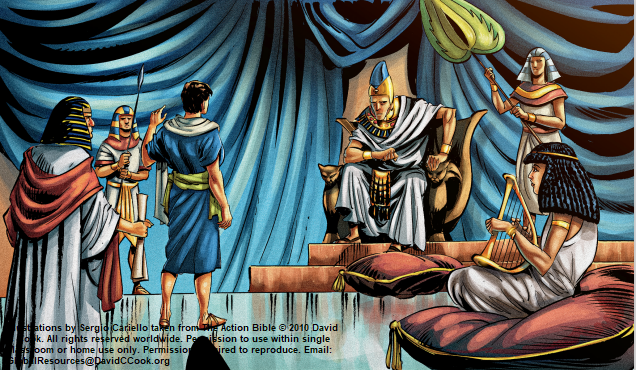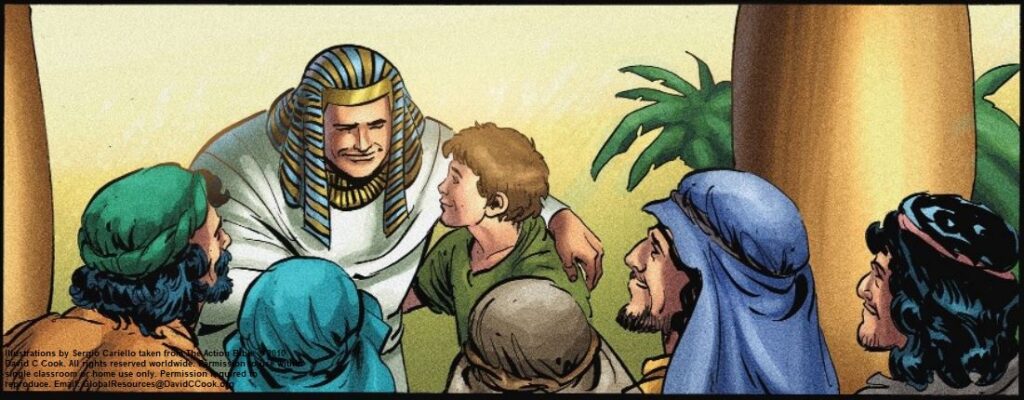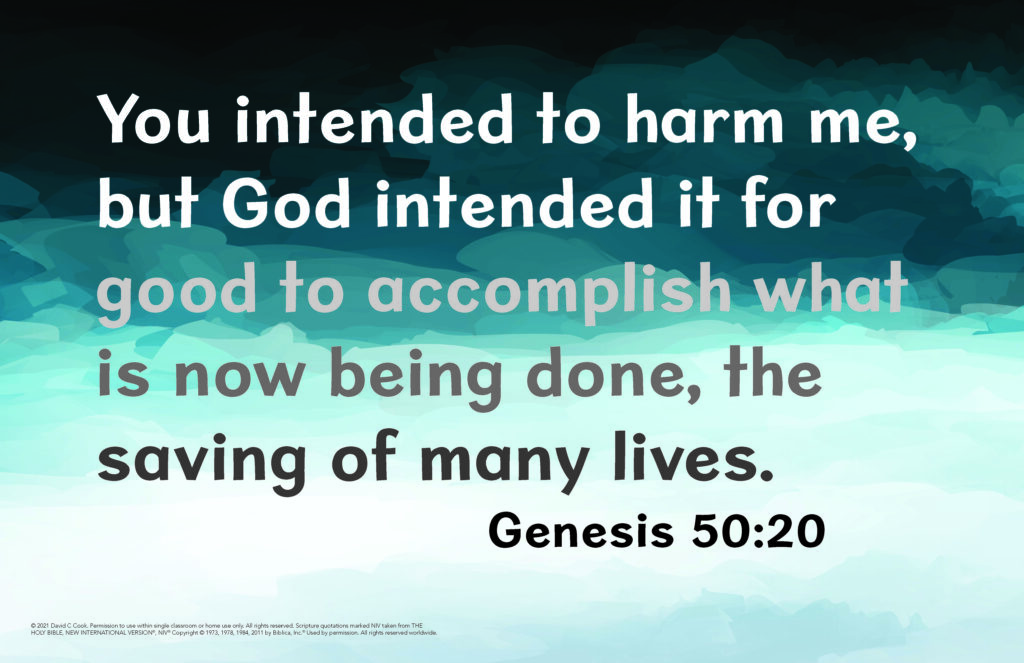During the lesson, the information for you to know is written in regular type, and what we suggest speaking or reading aloud to children is in bold. All resources for this lesson, including the Teacher Guide, Student Page, Family Connection Card, and other resources can be downloaded in a ZIP file by clicking on the following link:
In some lessons you will find "resource articles." These are articles written by experts from around the world to help equip you for your work with children and adolescents. Share them with parents or guardians if you consider it appropriate.
If you have paper available, cut out a circle about the size of your fist for each child to use in the Responding section of the lesson.
Not only so, but we also glory in our sufferings, because we know that suffering produces perseverance; perseverance, character; and character, hope. And hope does not put us to shame, because God’s love has been poured out into our hearts through the Holy Spirit, who has been given to us.
Romans 5:3–5
As a Christian, you do not need to fear suffering. God is with you, and what you go through will produce good fruit if you persevere. Hard times, loss, and temptation are used by God to build hope in our hearts.
When you lose your job, remember God is at work in you. When a loved one dies, remember Jesus has not removed His hand from you. When you are tired and do not have the strength to go on, remember that this trial is temporary but His promise to be with you is eternal.
Pray this week that God will do in your life what He did in Joseph’s. Pray that He will take what others mean for harm and use it for good. Pray that He will make you pure gold so that you may shine with His radiance and others will know that the God you serve is real and good.
Tell your families that you will be teaching about bouncing back from difficult situations. Encourage them to share with their children about a time they bounced back from a difficult situation. What helped them bounce back?
Teacher Tip: If possible, email or text the Family Connection Card to the families of your students.
Welcome the children warmly. Tell them you will start with a fun story.
Pick two volunteers to help you tell a story. Give the Sad Face cutout to the first volunteer to hold up near his head. As you tell the story about Sad Face, he should move Sad Face a little lower every time you pause to say “and” slowly.
The second volunteer will hold the sad-happy face cutout. As you tell Bouncy’s story, the volunteer should turn the face upside down so the sad or happy face matches what Bouncy is feeling. Whenever it is time to flip the face around, tap the shoulder of the child holding the sad-happy face.
We have two interesting people with us today. This is Sad Face. I do not know why he has such a funny name. (Hold up the sad face.) And this is Bouncy. She is sometimes sad (show the sad face), but she quickly recovers and bounces back with a cheerful attitude. (Flip the face so it is happy.)
Remember to read each “AND” slowly as the cue for the volunteer to lower the face.
One day, Sad Face was walking down the road. Suddenly, a motorbike splashed muddy water on him. AND (lower the sad face) he said, “What a terrible way to start the day. I am sure today is going to be a horrible day.” He grumbled about sitting in his dirty clothes at school all day. When he got to school, the results of the class exam were out. He had scored very low marks AND (lower the sad face) he felt bad about it. When he got home that evening, he discovered that his sister had received high marks, AND (lower the sad face) he was sure he would never be as smart as her. AND (lower the sad face) his mother scolded him for getting his school uniform dirty, even though it was not his fault AND (lower the sad face) he was upset about that. He began crying and crying and crying AND (lower the sad face) was so sad he just went to bed.
Now, let’s hear the story of Bouncy.
Bouncy lived in a children’s home with 40 other children. One day, she was in the market when she saw a mother buying her child a treat. She felt sad because she knew no one would buy her nice things like that (tap the child to show the sad face). Then Bouncy remembered the new shirt she had received at Christmas, and she thanked God for that. She felt much better after that. She knew God would give her good things (tap the child to show the happy face).
As Bouncy walked to school, another girl started teasing her because she had no parents. Bouncy quickly walked on. She felt sad to be teased (tap the child to show the sad face). She was angry with the girl for being so mean. Then she told herself the girl did not know what she was saying. The girl did not know that Bouncy actually had a Father—God. She smiled to herself (tap the child to show the happy face). God provided her with everything she needed. God loved her more than any other father could.
Bouncy was sometimes happy (tap the child to show the happy face) and sometimes sad. But every time she felt sad (tap the child to show the sad face), she remembered something good about her life, and she bounced back to happiness (tap the child to show the happy face)!
Have the children clap for the volunteers.
Show Bouncy’s smile and let the children answer.
Show the Sad face frown and let children answer.
Turn the face around to show the happy face again.
Bouncy has learned to have a positive attitude about life. When she feels bad, she tries to think about something happy instead. She thinks about positive things like we learned in the last lesson. She thinks about what is good, right, true, and lovely. Bouncy is resilient. Having a positive attitude is a good way to bounce back when bad or hard things happen.
Listen as I tell you the true story of Joseph. You have heard parts of this story before. Listen closely though for new things God might speak to you. Joseph was a lot like Bouncy. He was resilient and bounced back when bad things happened.
Have the children find a partner to sit by. The partners will talk together three times during the story.
Jacob’s favourite son was Joseph. But the more he showed his love to Joseph, the more jealous his other sons became. One day, Jacob gave a beautiful coat to Joseph. His brothers were very angry about this gift.
To make matters worse, Joseph had two dreams. In his first dream, there were bundles of grain. The bundles that represented Joseph’s brothers bowed down to Joseph’s bundle. In his second dream, the sun, moon and stars bowed down to him. When Joseph shared these dreams, his brothers did not believe they were from God. His brothers became very angry with Joseph.
One day the brothers were in the fields taking care of their sheep when Joseph showed up. His brothers grabbed him, stripped off his coat, and threw him into an empty well. Most of them wanted to kill Joseph. But when a caravan of merchants going to Egypt came by, the brothers decided to sell Joseph as a slave instead. In Egypt, the merchants sold Joseph to a government official named Potiphar.
Ask children to imagine they are Joseph as they discuss these questions with their partners:
Give children about 2 minutes to talk about these questions with their partners. Ask 1–2 pairs to share their ideas with the class. Then continue the story.
Joseph’s brothers took his coat and put goat’s blood on it. They gave it to his father. Jacob cried out, “Oh, no! My wonderful son Joseph has been killed by a wild animal.” Remember we learned that the brothers did not tell their father the truth.
In Egypt, Joseph worked hard for Potiphar, and Potiphar trusted him. One day Potiphar’s wife lied and accused Joseph of trying to attack her. Potiphar threw Joseph into prison.
Ask children to imagine they are Joseph as they discuss these questions with their partners:
Give children about 2 minutes to talk about these questions with their partners. Ask two different pairs to share their ideas with the class. Then continue the story.
Optional: If you are using The Action Bible, you can have the children can read today’s story on pages 96–98 instead of telling it to them. Pick up the lesson by asking the next question.
Even in prison, God was with Joseph. Though the Bible does not specifically say that Joseph prayed to God, we can tell from his words and actions that he learned to trust God.
One day, the cupbearer who served the king was thrown into prison. While in prison, he had a dream and told Joseph about it. God helped Joseph interpret the dream. He told the cupbearer that he would be released from prison in three days, and it happened.
After the cupbearer went back to work for Pharaoh (the king), he forgot about Joseph. Two years later, Pharaoh had two disturbing dreams. No one could tell him what they meant. Then the cupbearer remembered how Joseph had interpreted his dream, so the cupbearer told Pharaoh about Joseph.
Joseph was brought to Pharaoh. “I have heard that you can interpret dreams,” Pharaoh said.
If possible, show The Action Bible images as you tell the story.

Joseph replied, “I cannot, but God can.”
Pharaoh told Joseph his dreams, and Joseph told him their meaning. “Your dreams are a warning from God that there will be seven years of good crops followed by seven years of famine. You should appoint a wise officer to store grain during the seven good years so there will be enough food during the famine.”
Pharaoh put Joseph in charge of all of Egypt. Only Pharaoh was greater than Joseph. Everything happened just as Joseph had said. When the famine came, Egypt had enough food.
People came from other countries to buy food from Egypt. One day, some men from Canaan came to buy food. Joseph recognized them as his brothers, but they did not recognize him.
Later, when the brothers came to Egypt again to buy more food, Joseph told them, “I am your brother the one you sold into slavery. Do not be angry with yourselves. God has blessed me in Egypt. Go bring our father here, and I will take care of you all.”

Ask the children to imagine they are Joseph as they discuss this question with their partners:
Give children time to discuss with their partners. Add these points if they do not mention them. I trusted God. I did not give up. I did not let myself stay down. I looked at the positive side of things. I forgave those who hurt me.
Joseph’s positive attitude came from knowing that God was with him even when his circumstances were hard. Here is what Joseph later told his brothers:
Read Genesis 50:20 from your Bible.
Show the Memory Verse poster if you are using it.
You intended to harm me, but God intended it for good to accomplish what is now being done, the saving of many lives.
Genesis 50:20

Joseph’s brothers meant to harm him when they sold him as a slave, but Joseph learned that God used that bad thing for good. Many people’s lives were saved from starvation because Joseph became a leader in Egypt.
Joseph trusted God and depended on Him during hard times. Because of this, Joseph kept a positive attitude and bounced back from the bad things others did to him.
Let’s make a big smiley face badge for our classroom to help us remember that God helps us bounce back in hard times.
Allow the children to gather items from the room or outdoors to create a big smiley face on the floor—the bigger the better! They can use classroom items such as pencils and paper or nature items such as leaves, sticks, and pebbles. Encourage the children to make the smiley face for God as a prayer. The big smiley face can be like a badge for the classroom, marking the class as a place that is filled with children who look to God to help them bounce back from hard situations.
Optional Supplies: Give the children the paper circles you cut out before class. Let them colour the circles. They can add eyes and big smiles. They can keep these as a reminder to choose to bounce back when they are in hard times.
Ask the children what they can do in these difficult situations to help them bounce back:
Everyone experiences hard things. Joseph was sold into slavery and then thrown into prison for something he did not do. But God can help us bounce back with a positive attitude just like He helped Joseph. Our positive attitude comes from knowing that God is with us. He will be with us when we go through difficult things. He can use even the bad things to bring about something good just as He did with Joseph.
Optional: If you are using the Student Pages, there is space for children to respond to what they have learned about bouncing back.

Ask the children for specific prayer requests, and encourage them to pray for the requests.
Close class by praying this blessing based on Psalm 5:11 over the children:
Blessing: May you take refuge in God and be glad, even in hard times. May you sing for joy forever and know that God is always with you!
Lead the students in singing this quarter’s song, if possible.
Life on Life ©2020 David C Cook. Reproducible for home or classroom use only. All other uses require written permission from David C Cook [email protected]. All rights reserved.